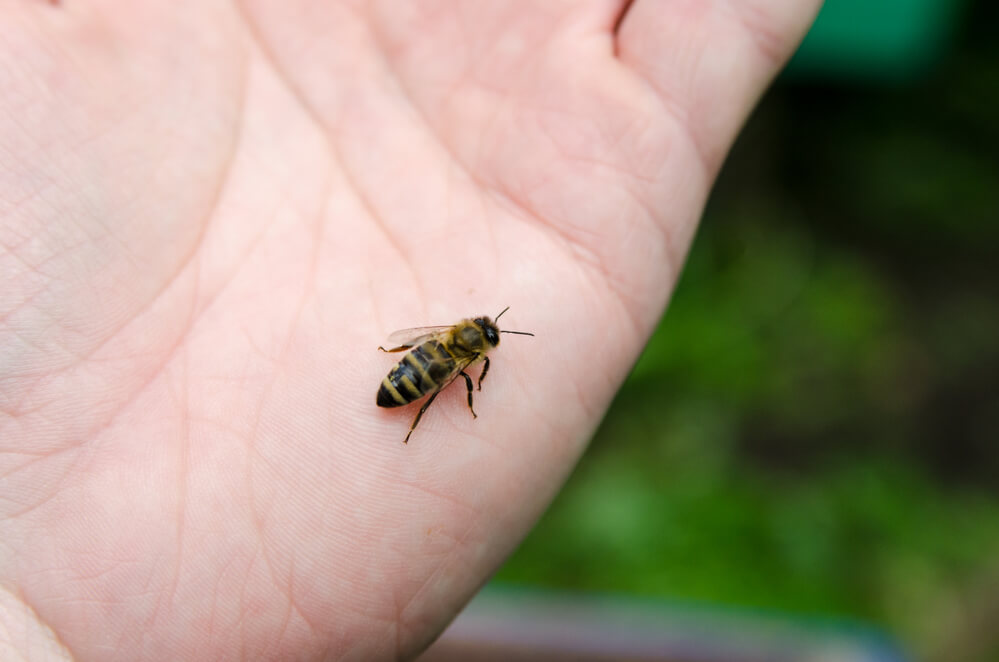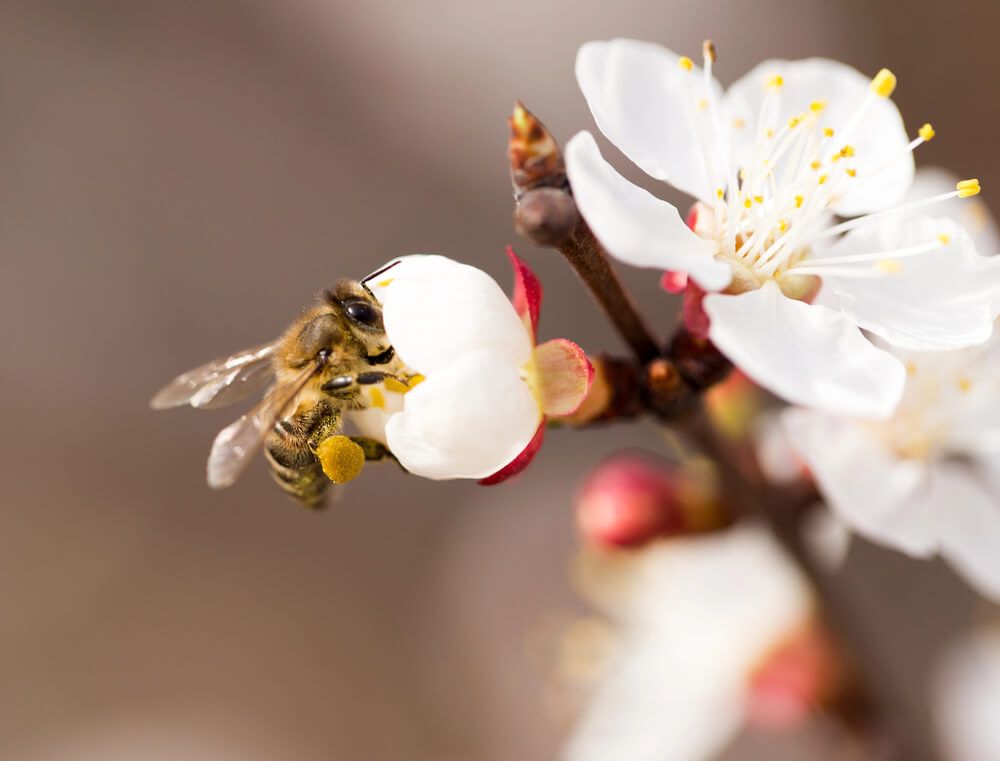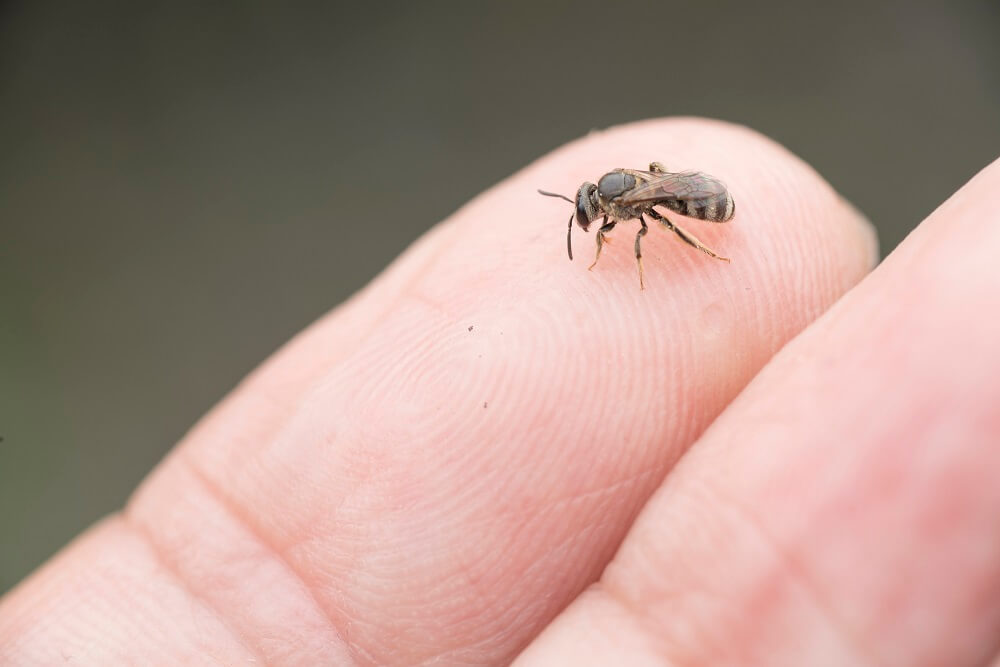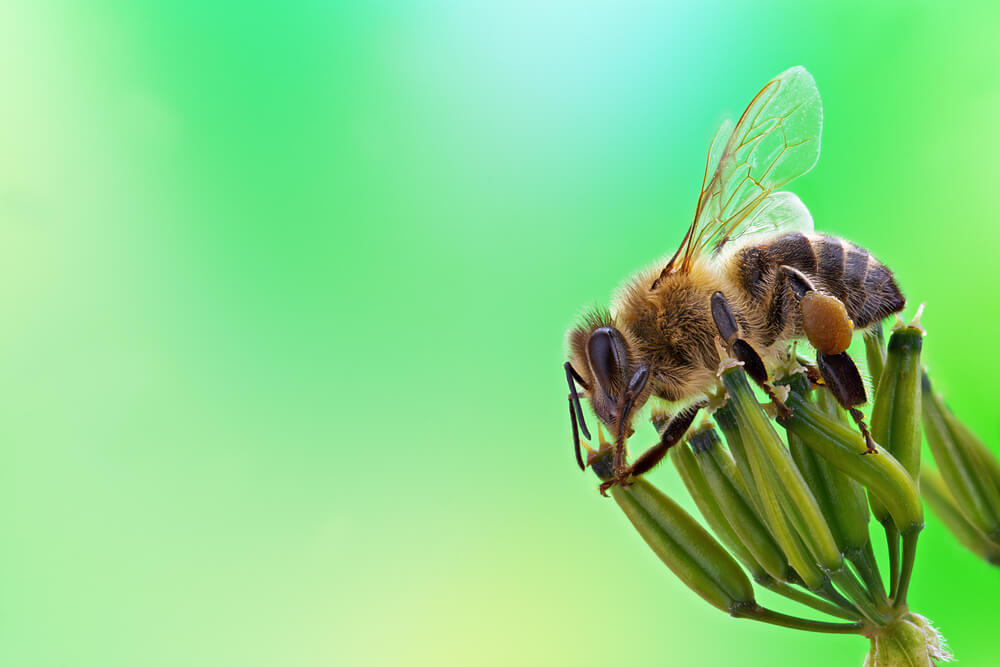Table of Contents:
How Long Do Bee Stings Hurt?
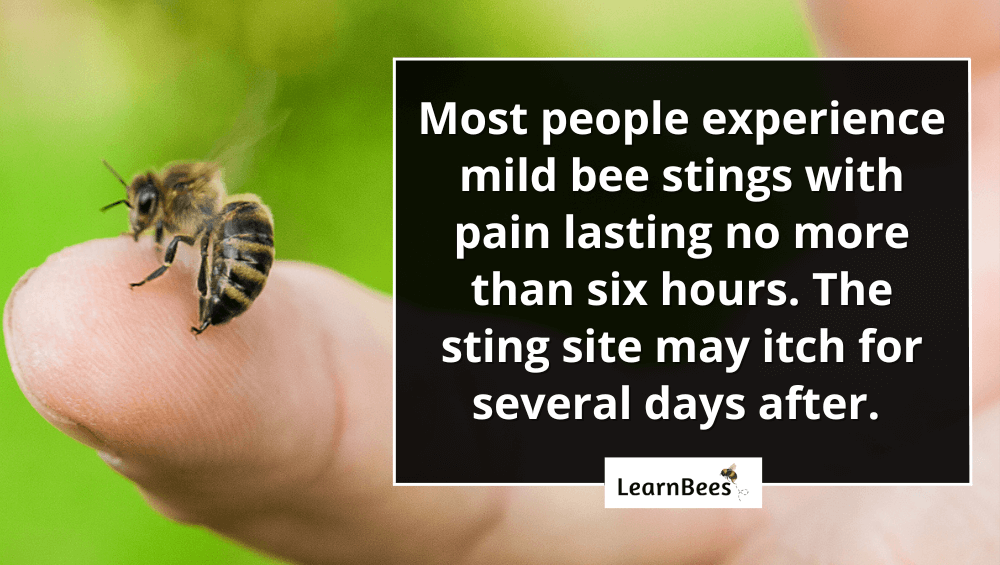
In most adults and children, bee stings will stop hurting within four to six hours after the sting. Both swelling and redness should subside by then, and you may be left with itching.(1, 2)
To help with the pain and itching:
Apply a thin layer of calamine lotion or hydrocortisone cream to the sting site area. Such products are good to have on hand during warm months when bees, wasps, and other stinging insects are active.(3)
But remember:
First, remove the bee’s stinger (if applicable), then wash the area with soap and water. Next, apply the calamine lotion or hydrocortisone cream to dry skin and cover it with a bandage.(4)
With that said, bee stings don’t affect everyone the same way.
For example, there’s a difference between a “thin skin” and a “thick skin” bee sting.
Thin skin stings hurt more, swell more, and have longer reactions. These occur in areas with more delicate skin, such as the back of your hands, forehead, and tops of your feet.
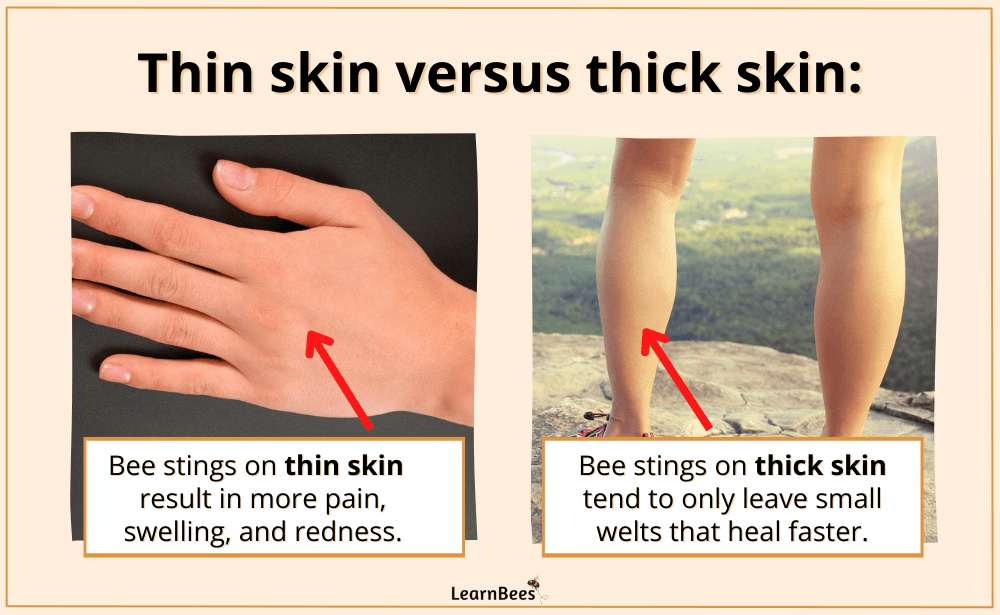
Thick skin bee stings leave small welts that go away quicker. Examples of thick-skin bee stings occur on the leg, thigh, and arm.
In either case, the main symptoms of bee stings are redness, swelling, pain, and itching around the sting site. Pain typically lasts no more than four to six hours, if that. Itching follows the pain and can last for several days.(5)
Most people experience quick relief by using calamine lotion or hydrocortisone cream. This can help decrease the itching and speed up the healing process.(6, 7)
- Mild bee sting reaction: 4-6 hours of pain at most, with other symptoms (itching, redness, swelling) lasting a few days
- Moderate bee sting reaction: 6-24 hours of pain, with other symptoms (itching, redness, swelling) lasting a few days
- Severe bee sting reaction: Swelling of the throat, lips, or tongue. Hives, lightheadedness, difficulty breathing, rapid heart rate. Severe reactions usually occur within one hour of the sting, and medical attention should be sought immediately.
How Do You Know if a Bee Stinger is Still in You?
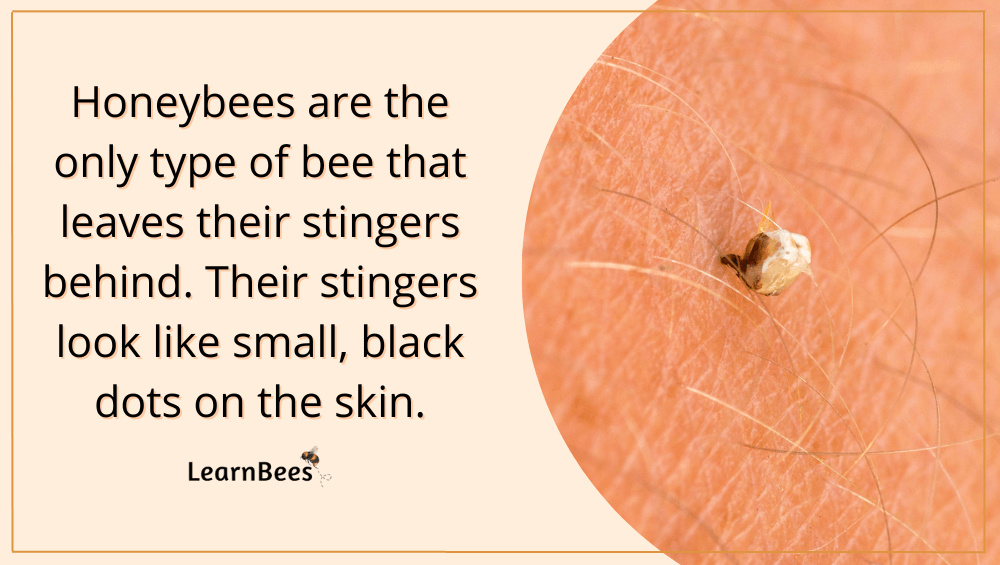
Bee stingers can look like small, black dots on the skin. You can remove them using a debit card to “scrape” them out. Pulling or pinching the stinger out isn’t ideal because it can squeeze more bee venom into you.(8, 9)
However, sometimes pulling or pinching is necessary.
That said, bee stingers can work their way out on their own, but it’s best to remove them immediately.
And keep in mind:
Most bees don’t even leave their stingers behind.
For instance, bumblebees, carpenter bees, and mason bees can sting multiple times without losing their stinger and dying. However, honeybees are the exception because they’re the only type of bee that loses their stinger.
So what does this mean?
You only need to worry about removing a stinger if you were stung by a honeybee. If you were stung by a wasp or other type of bee, then there was no stinger left behind in the first place.
When Should I Be Concerned About a Bee Sting?
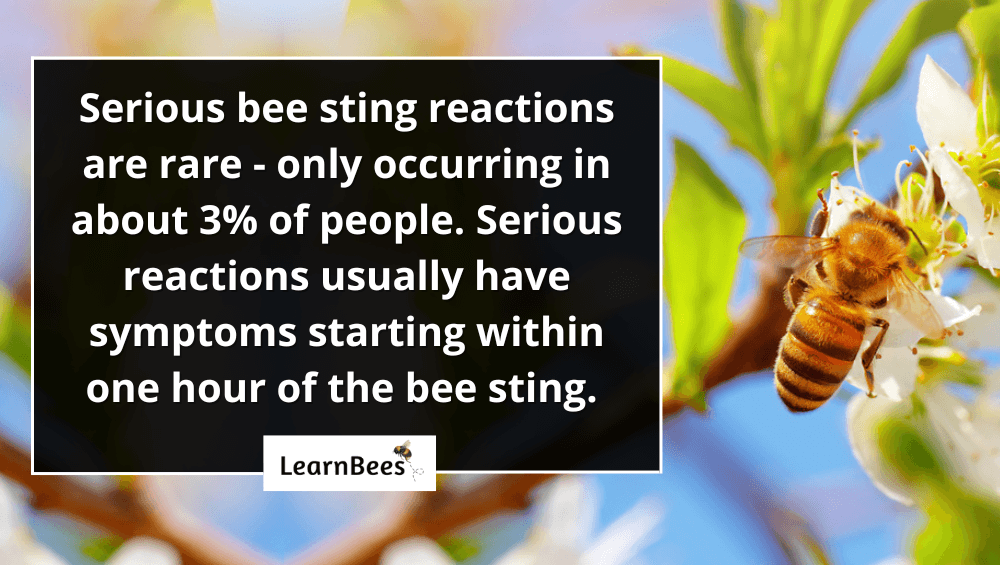
Fortunately, serious reactions to bee stings are infrequent – only occurring in about three percent of the population.(10, 11)
Pain, redness, swelling, and itching are all normal reactions after a bee sting. Don’t be alarmed if these symptoms last several days.(12)
With that in mind, serious bee sting symptoms include:
- Chest tightness
- Difficult breathing
- Hives
- Swelling on the lips, mouth, or throat
- Rapid heart rate
- Lethargy or dizziness
- Nausea, vomiting, or diarrhea
Seek medical attention if you experience any of these symptoms because they may indicate anaphylaxis. Anaphylaxis is a potentially life-threatening allergic reaction.(13)
If your doctor has prescribed an emergency epinephrine autoinjector (EpiPen, Auvi-Q, or others), use it immediately as your doctor instructed.(14)
Home treatment is enough for mild to moderate bee stings that don’t cause allergic reactions. Remove the stinger (if applicable), cleanse the skin with soap and water, and apply a calamine lotion or hydrocortisone cream.
FAQs on “How Long Do Bee Stings Hurt?”
- Why is my bee sting still hurting?
- How long does it take to have an allergic reaction to a bee sting?
- How long does a bee sting stay swollen?
- How long does bee venom stay in your system?
- Is it normal to experience muscle and joint pain after a bee sting?
- How do you know if a bee sting is still in you?
- How do you make a sting stop hurting?
- Should a bee sting hurt days later?
- Do stingers come out on their own?
- Can bee stings get worse over time?
- What will a doctor do for a bee sting?
- What hurts worse, a bee or a wasp sting?
- What does an infected bee sting look like?
- Can a bee sting without losing its stinger?
- Do bee stings get worse before they get better?
Why is my bee sting still hurting?
It’s normal for a bee sting to hurt for several hours to days. Make sure you’ve removed the stinger (if applicable), cleansed the sting site with soap and water, and applied calamine lotion or hydrocortisone cream.
From there, the pain should gradually lessen over a few days.
If the pain doesn’t lessen or gets worse, you should seek medical attention because this could be a sign of a serious reaction or infection.
—> Go back to the FAQs on “How Long Do Bee Stings Hurt?”
More to Explore:
How long does it take to have an allergic reaction to a bee sting?
Most serious bee sting reactions occur within the first hour after the sting.
However, it’s possible to have a delayed reaction that occurs several hours or even days after the sting.
Suppose you experience any serious bee sting symptoms (Chest tightness, difficulty breathing, hives, swelling on the lips, mouth, or throat, rapid heart rate, lethargy or dizziness, nausea, vomiting, or diarrhea). In that case, you should seek medical attention immediately, even if it’s been several hours or days since the sting occurred.
—> Go back to the FAQs on “How Long Do Bee Stings Hurt?”
More to Explore:
- How to Remove a Bee Stinger Stuck Under Skin
- What are Green Bees?
- The 10 Best Flowering Trees for Bees
How long does a bee sting stay swollen?
The swelling from a bee sting usually peaks within 24-48 hours but can last up to a week.
If the swelling is still present after a week or gets worse, you should seek medical attention because this could be a sign of an infection.
—> Go back to the FAQs on “How Long Do Bee Stings Hurt?”
More to Explore:
How long does bee venom stay in your system?
It depends on how much venom was injected into your skin. Removing the stinger quickly can reduce the amount of venom that you absorb. From there, bee venom should leave your skin within 48 hours for most people.
—> Go back to the FAQs on “How Long Do Bee Stings Hurt?”
More to Explore:
Is it normal to experience muscle and joint pain after a bee sting?
Minor muscle and joint pain can occur depending on where you were stung. For example, a sting close to the knee or elbow can cause joint pain in that area.
If the pain is intense or gradually increases, then seek medical care.
—> Go back to the FAQs on “How Long Do Bee Stings Hurt?”
More to Explore:
How do you know if a bee stinger is still in you?
Bee stingers look like small black dots on the skin. You can gently scrape it out using a card. If it’s difficult to remove or embedded in the skin, you may have to use tweezers.
But keep in mind:
Not all bees leave behind stingers. In fact, honeybees are the only bee species that lose their stinger. So, for example, if you were stung by a bumblebee, carpenter bee, or wasp, you won’t have to worry about removing the stinger.
—> Go back to the FAQs on “How Long Do Bee Stings Hurt?”
More to Explore:
How do you make a sting stop hurting?
You can take over-the-counter pain medication like ibuprofen (Advil) or acetaminophen (Tylenol).
If the pain is severe, you can apply a cold compress to the sting site for 15-20 minutes at a time. Also, use a calamine lotion or hydrocortisone cream to help with itch, pain, and redness.
—> Go back to the FAQs on “How Long Do Bee Stings Hurt?”
More to Explore:
Should a bee sting hurt days later?
People often ask:
Is it normal for a bee sting to hurt days later? Why is my bee sting hurting a week later? Why is my bee sting not going away? Can a bee sting have lingering effects?
The answer is that bee sting pain can last several days if you’ve experienced a moderate reaction. Make sure you’ve pulled out the stinger (if applicable), keep the area clean with soap and water, and use a calamine lotion or hydrocortisone cream.
If the pain is severe, it could be an infection sign. In this case, you should seek medical attention right away.
—> Go back to the FAQs on “How Long Do Bee Stings Hurt?”
More to Explore:
- Ground Bees: Are They a Threat to Your Yard?
- Wasps vs. Honeybees: Are They Different?
- Do Bumble Bees Bite?
Do stingers come out on their own?
Yes, bee stingers can come out on their own. However, removing the stinger immediately after the sting occurs is best. This can help reduce the amount of venom injected into your skin.
If you’re unsure whether the stinger is still in your skin, you can gently scrape the area with a credit card or use tweezers to remove it. But in most cases, stingers appear as small black dots on the skin.
—> Go back to the FAQs on “How Long Do Bee Stings Hurt?”
More to Explore:
Can bee stings get worse over time?
In most cases, bee stings improve over time instead of getting worse. However, you might initially notice strong symptoms appear after the first few hours following the stinging incident. From there, symptoms should subside.
Mild bee sting reactions last no more than a few hours to a few days. Some people may experience worsening symptoms such as swelling, redness, and itchiness for up to a week.
If you’re still experiencing symptoms after a week or if your symptoms are getting worse, then you should seek medical attention.
—> Go back to the FAQs on “How Long Do Bee Stings Hurt?”
More to Explore:
- Do Carpenter Bees Pollinate?
- How Long Do Bumble Bees Live?
- Honeybees vs. Bumblebees: How Do They Compare?
What will a doctor do for a bee sting?
Doctors will cleanse the sting site area for moderate reactions and apply a steroid cream or calamine lotion to help with itch, pain, and redness. If you’re still experiencing pain, they may prescribe an over-the-counter pain medication like ibuprofen (Advil) or acetaminophen (Tylenol).
Doctors will likely give you a shot of epinephrine for severe reactions to stop the reaction. You may also be prescribed an antihistamine or a steroid medication.
—> Go back to the FAQs on “How Long Do Bee Stings Hurt?”
More to Explore:
- Do Queen Bees Eat Honey?
- Are Worker Bees Male or Female?
- Queen Bee Versus Worker Bees – How Do They Compare?
What hurts worse, a bee or a wasp sting?
On average, wasp stings hurt more than bee stings. Additionally, wasps can sting several times without losing their stinger and dying. On the other hand, honeybees die after stinging because their stinger gets stuck in the skin.
However, it’s important to remember that everyone experiences pain differently. So, while one person may find a wasp sting more painful than a bee sting, another person may have the opposite experience.
—> Go back to the FAQs on “How Long Do Bee Stings Hurt?”
More to Explore:
What does an infected bee sting look like?
Infected bee stings have increased pain, swelling, and redness. You may also experience pus or a yellow discharge from the sting site. Additionally, the sting site may feel warm or sensitive to the touch.
—> Go back to the FAQs on “How Long Do Bee Stings Hurt?”
More to Explore:
Can a bee sting without losing its stinger?
Honeybees are the only type of bee that loses their stinger after stinging. Other types of bees, like bumblebees and carpenter bees, keep their stinger and can sting multiple times.
—> Go back to the FAQs on “How Long Do Bee Stings Hurt?”
More to Explore:
Do bee stings get worse before they get better?
Yes, bee stings can get worse before they get better. For example, you may experience a localized reaction (redness, swelling, and pain) that increases in severity over the first few hours after the sting occurs.
In some cases, bee stings can also lead to more serious reactions like anaphylaxis. Anaphylaxis is a potentially life-threatening condition that requires immediate medical attention. Symptoms of anaphylaxis include difficulty breathing, dizziness, and swelling of the face or throat.
However, serious reactions like anaphylaxis are rare and occur in about 3 percent of the population.
If you experience any of these symptoms after being stung by a bee, you should call 911 or go to the nearest emergency room immediately.
